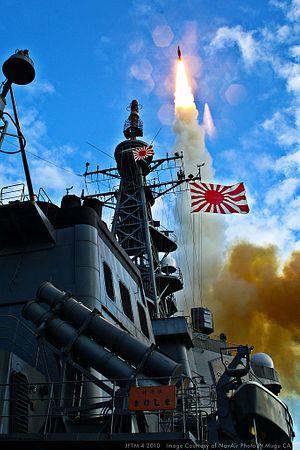On June 29, the Japanese government lowered the Self-Defense Force (SDF) alert level against a possible North Korean missile launch.
In response to Pyongyang’s missile tests, Japan had been on a state of high alert since August 2016, deploying up to two Maritime Self-Defense Force (MSDF) Aegis-equipped vessels with SM-3 interceptor missiles. Additionally, after Pyongyang threatened it would launch missiles into the vicinity of the U.S. territory of Guam and North Korean missiles flew over southern Hokkaido, Japan deployed three units in charge of PAC-3 surface-to-air missiles at Ground Self-Defense Force (GSDF) bases in August 2017. According to government sources who spoke to Asahi Shimbun, the decision to downgrade the alert level was made because the SDF members with the Aegis vessels and PAC-3 missile units were being stretched too thin due to the prolonged alert period.
Specifically, the downgrading of the alert level means that MSDF’s Aegis destroyers will be given 24 hours to be ready to intercept North Korean missiles, instead of being kept on alert around the clock in the Sea of Japan. While the PAC-3 missile launchers and the control system will remain deployed at GSDF bases, the Air Self-Defense Force members operating them will also be given 24 hours to be ready instead of having to maintain constant readiness.
While some government officials continue to urge caution due to the lack of progress in Japan-North Korea relations, the June 12 U.S.-North Korea summit succeeded in mitigating at least some Japanese concerns. Summarizing the current security situation, Chief Cabinet Secretary Yoshihide Suga stated following the summit, “Japan is clearly not in a situation in which North Korea’s missiles may fly toward the country at any time.”
Such optimistic, short-term moves are poignant, especially when contrasted with more long-term trends that reflect a more pessimistic mood.
According to sources who spoke to Yomiuri Shimbun, the Ministry of Defense (MOD) plans to install Lockheed Martin Corp’s Aegis Ashore units, which will allow for monitoring of the entire Korean Peninsula around the clock from Akita and Yamaguchi prefectures. The Solid State Radar (SSR) uses the same technology that the United States is using in its radar system currently under construction in Alaska. The maximum detectable range of the SSR is more than 1,000 kilometers, more than double the detectable range of the radar currently installed on an MSDF Aegis destroyer. Once the system becomes operational, currently targeted for 2023, it can free up the MSDF Aegis destroyers to focus on monitoring Chinese activities in the East China Sea.
This may be another case of what Christopher Hughes has termed “super-sizing” the North Korea threat – using the North as a cover, or “proxy threat,” for defensive developments more aimed against China. Because North Korea is seen as less legitimate for an international actor, it is politically less costly for Japan to point the finger at North Korea than it is to point the finger at China.
But in this era of Trumpian, transactional international relations, upgrading Japan’s missile defense system may important for another reason: though this is an ancillary benefit rather than the primary motivation, the Aegis Ashore system, which will likely cost twice as much as Japan’s initial estimate, will help balance the U.S.-Japan trade deficit – as Trump has been exhorting Japan to.
The world got its first teaser of Trump’s business-first approach to arms transfer policy this past April at a joint press conference in Florida with Japanese Prime Minister Shinzo Abe when he promised policy changes that will “short circuit” the government bureaucracy and allow major arms deals to be concluded on a much faster timetable. But Trump had been applying pressure directly on Japan even before then: he made headlines last November when he stood next to Abe at the Akasaka Palace in Tokyo and said, “The prime minister of Japan is going to be purchasing massive amounts of military equipment, as he should. It’s a lot of jobs for us and a lot of safety for Japan.”
Though in substance Japan’s purchase of an advanced land-based missile defense system ought to be commended as a step forward in responsibly bolstering its security, it is difficult to herald it as a positive development in Japan-U.S. relations when it occurs against this backdrop.
Japan is facing an undoubtedly more hostile international environment. But even worse than developments in North Korea and China is the specter of its patron-ally abandoning the very core principles that have bound Japan and the United States together since the end of World War II.

































